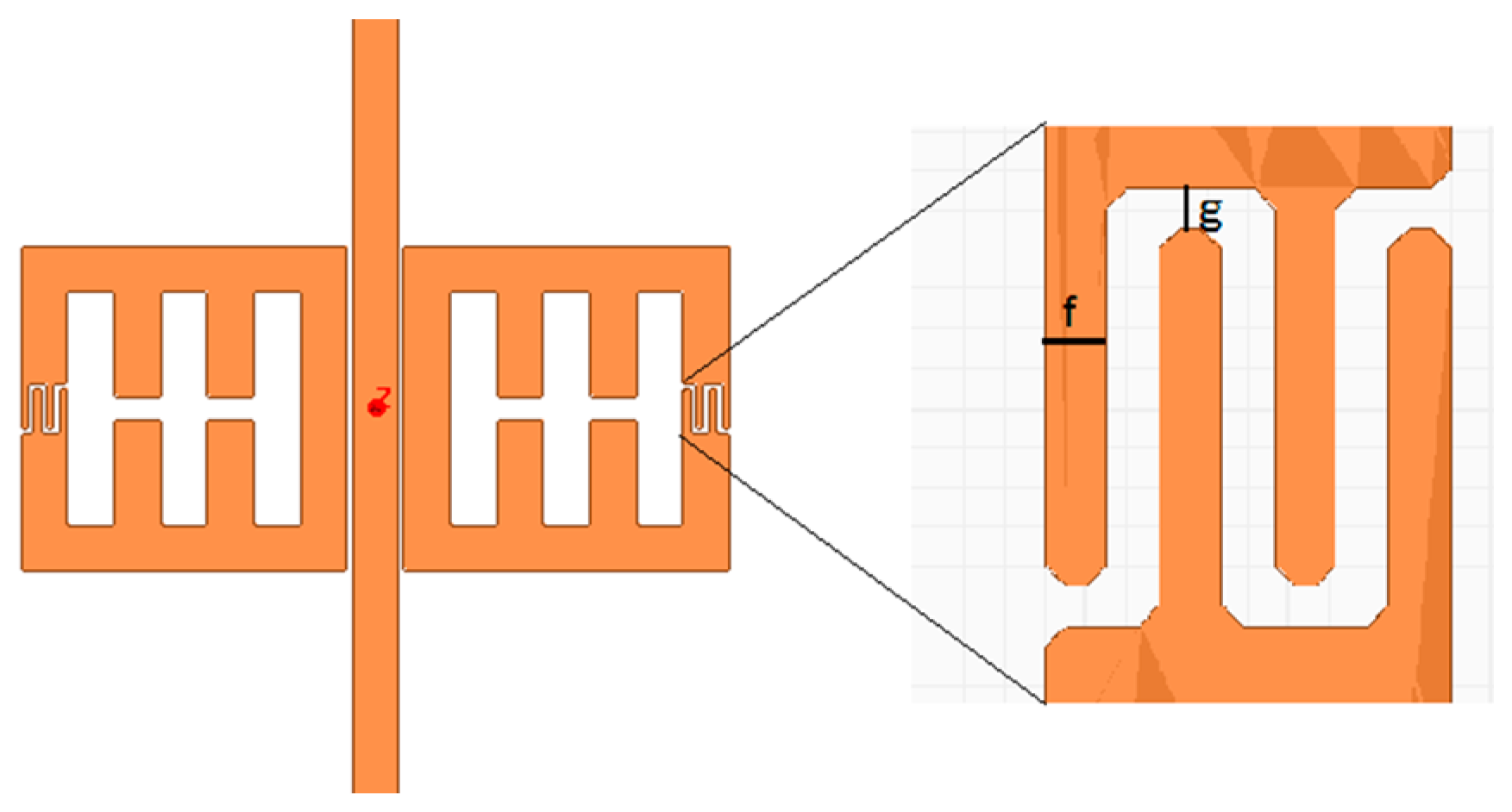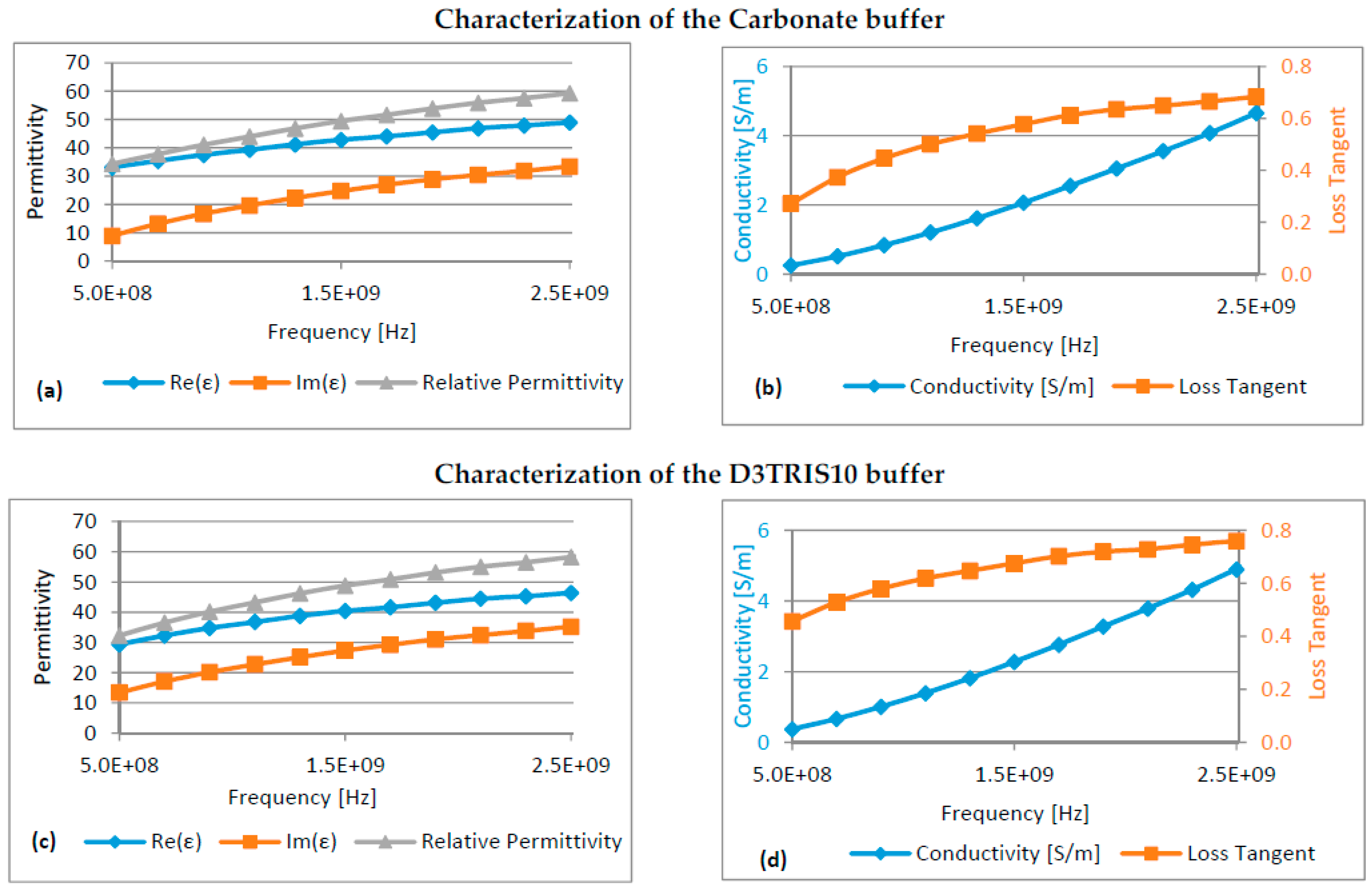Electromagnetic Characterization and Simulation of a Carbonate Buffer System on a Microwave Biosensor †
Abstract
:1. Introduction
2. Materials and Methods
2.1. Improvement of the Geometry
2.2. Characterization of the Buffer Droplet
2.3. Positioning of the Buffer Droplet
3. Discussion
Acknowledgments
Conflicts of Interest
References
- Strasser, F.; Melnik, E.; Muellner, P.; Jiménez-Meneses, P.; Nechvile, M.; Koppitsch, G.; Lieberzeit, P.; Laemmerhofer, M.; Heer, R.; Hainberger, R. Preparation of Mach-Zehnder interferometric photonic biosensors by inkjet printing technology. In Proceedings of the SPIE Optics and Optoelectronics, Prague, Czech Republic, 24–27 April 2017. [Google Scholar]
- Melnik, E.; Strasser, F.; Muellner, P.; Heer, R.; Mutinati, G.C.; Koppitsch, G.; Lieberzeit, P.; Laemmerhofer, M.; Hainberger, R. Surface Modification of Integrated Optical MZI Sensor Arrays Using Inkjet Printing Technology. Procedia Eng. 2016, 168, 337–340. [Google Scholar] [CrossRef]
- Zajicek, R.; Oppl, L.; Vrba, J. Broadband measurement of complex permittivity using reflection method an coaxial probes. Radioengineering 2008, 17, 14–19. [Google Scholar]
- Wagner, L.-M.; Voglhuber-Brunnmaier, T.; Brandl, M. Optimization of a Biosensor Device based on a microwave Split-Ring Resonator. In Proceedings of the Conference on Micro- and Nano-Engineering (MNE2016), Vienna, Austria, 19–23 September 2016. [Google Scholar]
- Reinecke, T.; Walter, J.-G.; Kobelt, T.; Ahrens, A.; Scheper, T.; Zimmermann, S. Biosensor based on a split-ring resonator. In Proceedings of the Sensors 2017, Nuremberg, Germany, 30 May–1 June 2017. [Google Scholar]





| D3TRIS10 | Carbonate | |||
| 2 | 11 | 2 | 11 | |
| (MHz) | 30.4 | 30.9 | 30.7 | 30.4 |
| (%) | 1.71 | 1.73 | 1.72 | 1.71 |
Publisher’s Note: MDPI stays neutral with regard to jurisdictional claims in published maps and institutional affiliations. |
© 2017 by the authors. Licensee MDPI, Basel, Switzerland. This article is an open access article distributed under the terms and conditions of the Creative Commons Attribution (CC BY) license (https://creativecommons.org/licenses/by/4.0/).
Share and Cite
Wagner, L.-M.; Strasser, F.; Melnik, E.; Brandl, M. Electromagnetic Characterization and Simulation of a Carbonate Buffer System on a Microwave Biosensor. Proceedings 2017, 1, 276. https://doi.org/10.3390/proceedings1040276
Wagner L-M, Strasser F, Melnik E, Brandl M. Electromagnetic Characterization and Simulation of a Carbonate Buffer System on a Microwave Biosensor. Proceedings. 2017; 1(4):276. https://doi.org/10.3390/proceedings1040276
Chicago/Turabian StyleWagner, Lisa-Marie, Florian Strasser, Eva Melnik, and Martin Brandl. 2017. "Electromagnetic Characterization and Simulation of a Carbonate Buffer System on a Microwave Biosensor" Proceedings 1, no. 4: 276. https://doi.org/10.3390/proceedings1040276





